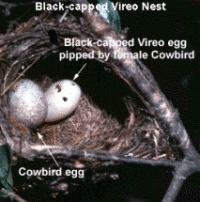
In reply to my previous post about Brown-headed cowbirds, I got exactly the information I was looking for from fellow blogger, gardenpath. She posted a site for Lakota language words that I hadn't seen before. I have friends who are Blackfoot and Flathead speakers, and a Cree-speaking friend who knows a little Lakota, but not enough to tell me about the cowbirds. So the link is a very handy one. It gives the Lakota word for "cowbird" as "pteyahpa" and also the word "pte" for a cow buffalo. Since this vocabulary is alphabetized by the Lakota terms, I checked for "yahpa" and for "eyahpa" but there isn't anything that could be a generic word for bird to combine with "pte." I'll take some time this weekend and go over all the rest to see if there are any others.
The link where I got the photo is an excellent one for extra info on these birds. They really can be quite aggressive, not just laying eggs, but also evicting young tenants they find already in the host nest. I do feel protective towards the small songbirds, especially the more endangered ones, but as I mentioned in yesterday's post, it's not the "fault" of the cowbirds. We humans are the one who have upset the balance, with too few forests and a lot more domestic livestock kicking up insects. In a moment of reverie I wondered if, since there are no more great nomadic herds, cowbirds might one day learn to build their own nests and rear their own young. But things change because they are selected for it, as Darwin observed, and so cowbirds would probably only change their age-old behavior if a new external force pressures them to, and they seem to have it pretty easy the way things are right now.
The only question that remains for me is a little more on how the Buffalo (cow)Bird was regarded by aboriginal peoples back in the buffalo days. I read that the birds not only ate insects stirred up by grazing buffalo, but they also rode on their backs and picked insects like an Oxpecker. In winter, the birds would nestle down into the wool and keep warm. So, they were year-round companions. I thought that cowbirds might have been singled out for special recognition among people who depended on buffalo for survival. Seeing a cowbird in the trees by the river might mean there was a herd just over the next hill. I don't know if I'll ever know the answer to that one, but it's still nice to ponder. And thanks to Gardenpath for the excellent sleuthing!
Photo source and information http://www.tpwd.state.tx.us/huntwild/wild/nuisance/cowbirds/











4 comments:
"We humans" have so very much to answer for, in so many areas. Do you think we will ever learn? It seems doubtful.
I an going to see if I can find the Cherokee words for birds-- you have gotten me interested. My family lives in the town where the western band of Cherokees have a great presence. Tahlequah, Ok.
I love the way you acquired this information! Wow. These birds are new to me, thanks to you. God bless.
I have really been enjoying these posts of investigation. I know what you mean - here we have grackles which are very dominant. They don't mess with our feeder though.
Post a Comment